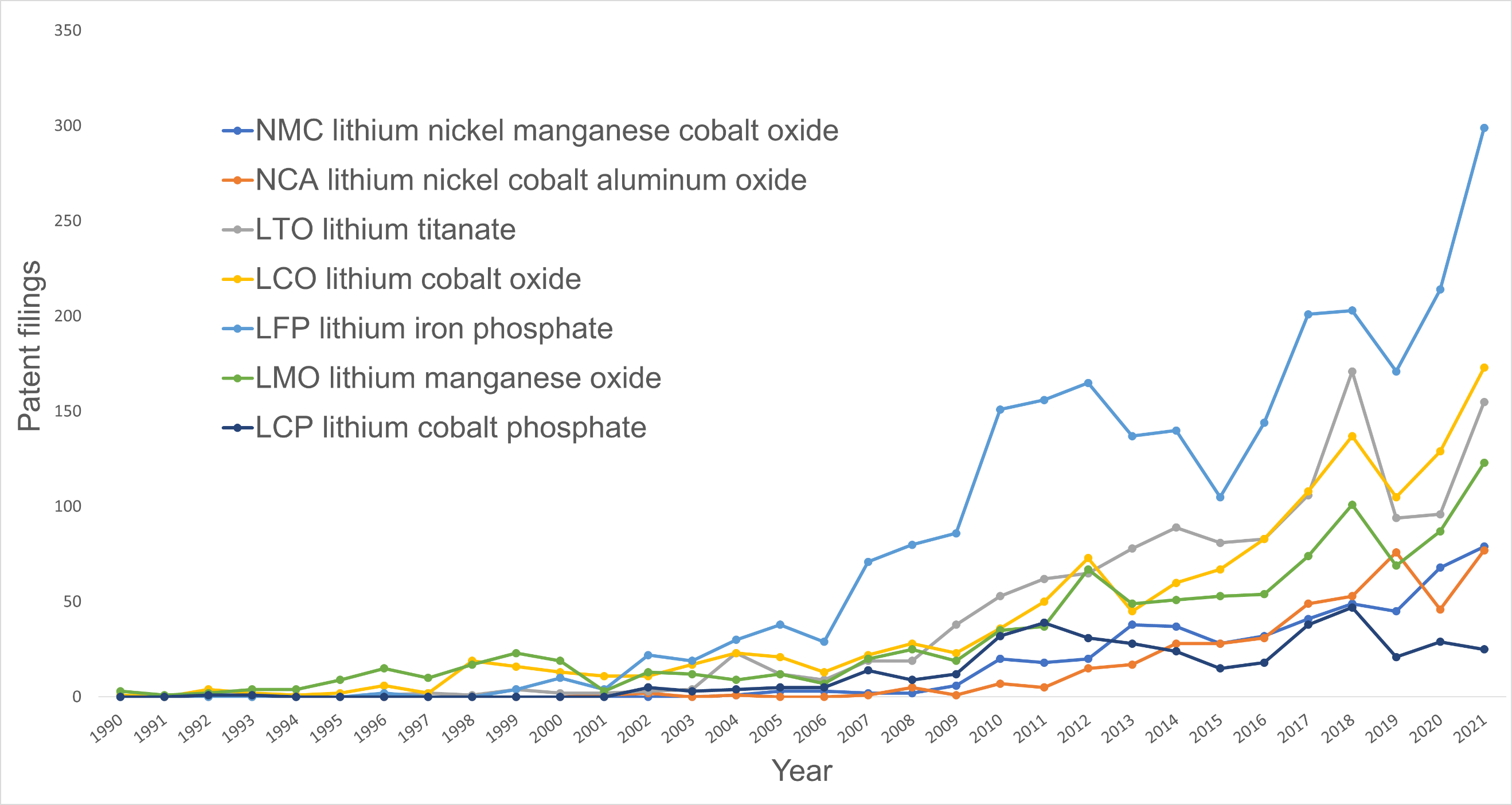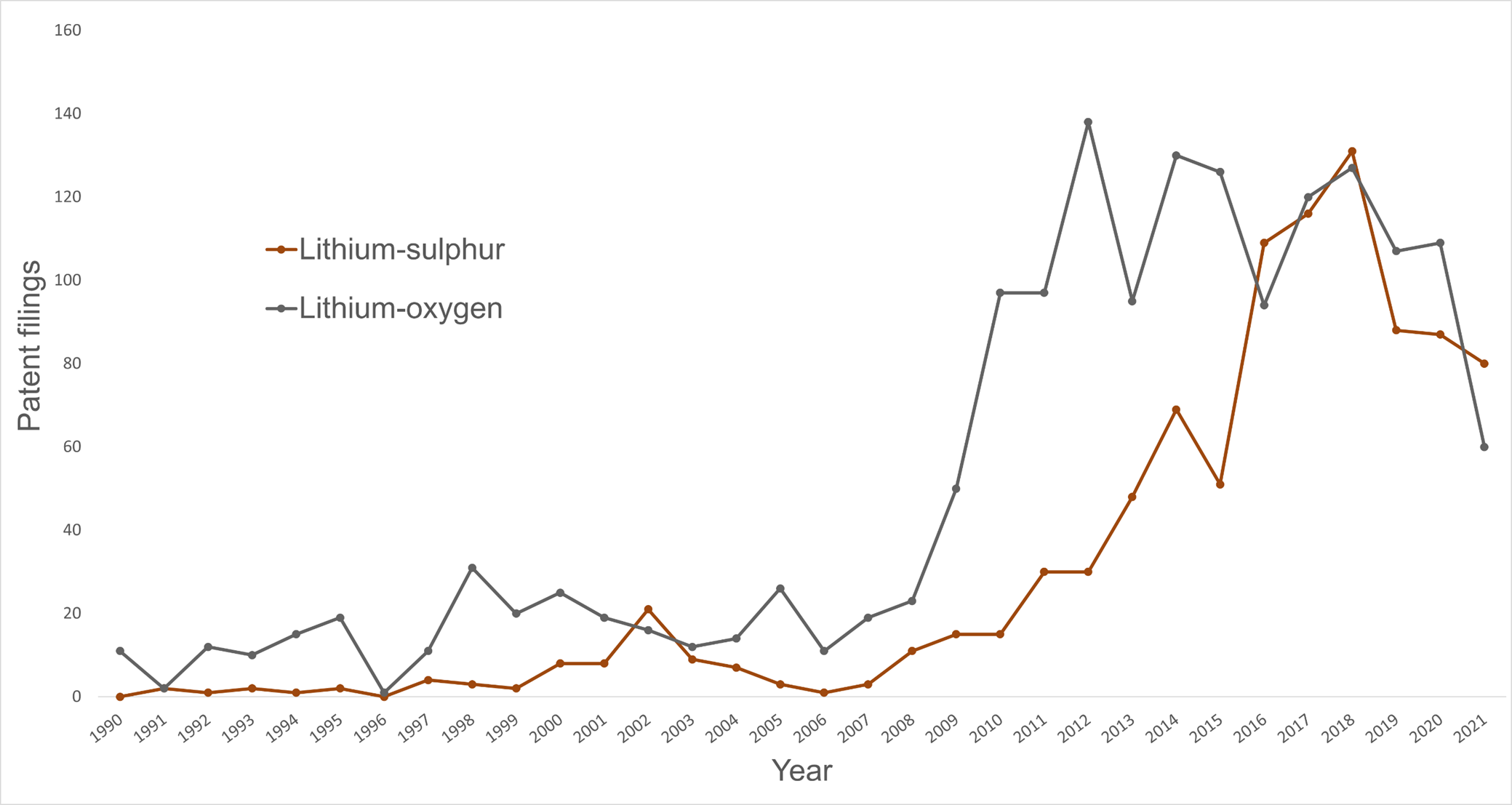Part 1 of this mini-series looked at patent filing trends for different core battery chemistries and solid electrolytes and speculated whether they provide insight into the progress of the battery industry. In part 2, we apply the same approach to battery electrode materials, with some surprising results.
Cathode materials
As a lithium ion battery is discharged, lithium ions migrate from one electrode (the anode) to the opposite electrode (the cathode). A good cathode provides the battery with a high voltage and can be cycled many times.
Cathode materials are topical because the highest performing ones (such as nickel manganese cobalt oxide or “NMC”) are sensitive to supply chain issues, and there are ethical concerns around the working conditions in the countries in which their constituent metals are mined. This has led to an uptake in the use of alternative cathode materials, such as LFP (lithium iron phosphate), which is now found in the majority of new Tesla vehicles. Cost and supply are not the only considerations however. As well as being more readily available than NMC, LFP performs well over a wider range of temperatures and is less prone to overheating.
Figure 1 compares annual patent filing statistics for a broad range of cathode materials. We see that the data agrees with current market trends in that LFP filings are significantly higher than for other materials. Behind LFP, there is no clear second place with interest steadily growing in a variety of materials. As such, it looks as if the popularity of LFP will continue for the foreseeable future. While filing numbers for other materials are lower, they are still significant and we can expect the development of other cathode materials for high performance vehicles to continue while the search for an alternative to LFP with similar cost/performance ratio goes on.

Metal-anode batteries1
Conventional lithium ion batteries comprise a graphite anode electrode that stores lithium ions when charged. Metal anode batteries do away with graphite and instead reduce metal ions to their corresponding metal during charging. This results in a substantial weight saving while increasing the energy that can be extracted from each ion, significantly increasing the theoretical maximum range of an electric vehicle. With this promise come technical challenges that have so far prevented mass uptake of such batteries.
Two of the most explored metal-anode battery chemistries are lithium-oxygen (or “lithium-air”) and lithium-sulphur. Both of these have been the subject of extensive research over the past several decades. However, our findings in Figure 2 show that new filings peaked in 2018.

While we have found a general decline in filing numbers for all patents relating to lithium metal anode batteries, this conflicts with regular reports of progress in this area, so it remains to be seen whether the surge in popularity of electric vehicles or a new breakthrough will reverse this trend.
Conclusion
If we look to patent filings as a key indicator, steady improvements in battery capacity, lifetime and safety through refinement of lithium ion technology seem likely over the next few years, with continued development of cathode materials playing an important role. Despite their allure, more work is needed before we see the mass uptake of metal-anode batteries and the step change in performance they can provide.
If there is an aspect of battery technology you are excited about which we have not yet looked at, or you have any other thoughts on batteries and cleantech you would like to share, please don’t hesitate to reach out to Nico Cousens.
1Search strategy: limited to claims only; search string for each technology includes “battery” or "electrochemical cell"; limited to Cooperative Patent Classification H01M (“PROCESSES OR MEANS, e.g. BATTERIES, FOR THE DIRECT CONVERSION OF CHEMICAL ENERGY INTO ELECTRICAL ENERGY”); limited to PCT, European and US filings; complete data for filings beyond 2021 unavailable at time of search due to 18 month publication delay for patent applications.